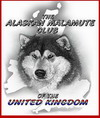 |
Alaskan Malamute Breed History |
A BRIEF HISTORY OF THE Alaskan Malamute
The Alaskan Malamute evolved from the ancient dogs that accompanied prehistoric man on his migrations from Asia across the Arctic to Greenland and back. These migrations covered thousands of years. They produced a natural evolution of species that varied from the long coated varieties found in Greenland to the lesser coated, longer legged varieties found in the forest and lake areas of Canada.
Early Russian and English explorers often reported a superior and better-kept type of work dog used by the “Mahlemut” (Malemiut, Mahlmuit, Malemuit) tribes around the Norton Sound area of Alaska. They were less “wild”, more tractable and capable of an enormous amount of work. It must be kept in mind that these were work animals. They were used in hunting seals, were set loose in packs to course the polar bear, to haul heavy sledges, or pack supplies. Although treated with fondness and exceptional care, here were no room for “pets” on the cruel ice packs and tundra.
With the Gold Rush, the demands for pack and sled dogs brought to Alaska all types of breeds that could survive the weather. Soon, especially near the populated areas, these dogs were quite a mixture of breeds and quality. One had to travel many days inland, out into the gold country to find any semblance of the original Alaskan sled dog. Due to their relative isolation, the dogs of the “Mahlemut” remained fairly “pure”, but they too suffered from the inroads of civilisation.
Chinook Kennels, established by Arthur T Walden, and later by Milton and Eva Seeley in New Hampshire, was one of the main sources for sled dogs used in the Byrd Antarctic expeditions in the early thirties. The Seeleys began a programme to reproduce those dogs that were typical of the dogs found in the Norton Sounds area. “Kotzebue” applies to the main strain of Alaskan Malamutes at Chinook Kennels established by the Seeleys.
A slightly different strain was developed by Paul Voelker Snr., and Paul Voelker Jnr., with dogs they brought from Alaska in the early 1900’s, and later in the 1920’s. These were generally known at the “M’Loot” strain, named after the kennel established by the Voelkers. Some of these dogs saw service in World War 1 and World War 2, and with Admiral Byrd’s second expedition. Ralph and Marchetta Schmitt of Silver Star Kennels purchased some of the Voelkers dogs to further establish the “M’Loot” strain. These two terms “Kotzebue” and “M’Loot” are often used to describe the genetic background of the present day Malamute whether the current dogs resemble their ancestors or not.
Reprinted by kind permission of Wendy Willhauck, AMCA Judges Education Co-ordinator